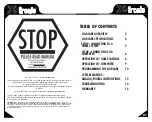
76
PID Sets & Gain Scheduling
Up to 5 sets of PID tuning terms can be entered for each
control loop, allowing the instrument to be pre-set for
differing conditions. Each set has individual values for
the following parameters: Primary Proportional Band;
Secondary Proportional Band; On-Off Differential; Inte-
gral Time; Derivative time; Overlap/Deadband. The pa-
rameter values can be entered in the control configura-
tion sub menu (page 50), but also see Automatic Tuning
below for automatic tuning of the PID sets.
The PID sets might be configured for different applica-
tions, or to allow for differing process or load conditions
that might occur in a single application. In this case one
set at a time would be selected as the “Active PID” set
for that loop.
Alternatively, if the process conditions change signifi-
cantly during use (e.g. if it is partially exothermic as the
temperature rises) Gain Scheduling can be employed.
Gain scheduling ‘bumplessly’ switches PID sets auto-
matically at successively higher setpoint or process val-
ues, giving optimal control across a wide range of pro-
cess conditions. This is explained in the diagram below.
PID Set 1
PID Set 2
PID Set 3
PID Set 4
PID Set 5
PV or SP
Scale Upper Limit
Scale Lower Limit
Breakpoints
PID set 1 is used from the scaled input lower limit until
the “breakpoint” for set 2 is passed and that set be-
comes active.
Set 2 is then used until the breakpoint for Set 3 is
reached etc.
If any breakpoint is set to OFF, the subsequent PID sets
are not used.
The final set continues from the last breakpoint to the
scaled input upper limit.
Gain Scheduling breakpoints can be selected to switch
PID sets with a change in the current setpoint value, or
the current process value.
Note:
ON/OFF control is possible with the individual
PID sets but cannot be used with gain scheduling. On/
off control is replaced with the default proportional
band if gain scheduling is turned on.
If the a change to the scale lower or upper limits forces
any of the breakpoints out of bounds, all breakpoints
will be turned off and the instruments uses the default
PID set 1.
Automatic Tuning
To automatically optimize the controllers tuning terms
for the process, you can use Pre-Tune, Self-Tune or
Auto Pre-Tune independently for each control loop.
Note: Automatic tuning will not engage if either pro-
portional band is set to On/Off control. Also, pre-tune
(including an auto pre-tune attempt) will not engage if
the setpoint is ramping, if a profile is running, or if the
Process Variable is <5% of span from setpoint.
Pre-Tune
Pre-tune performs a single disturbance of the normal
start-up pattern so that a good approximation of the
ideal PID values can be made prior reaching setpoint. It
automatically stops running when the test is complete.
The user chooses which PID set the new tuning terms
will be applied to, but this selection does not change
the selected “active PID set”. This allows tuning of any
PID set for future use before return to control with the
current PID set.In VMD mode, derivative is not applied
by pre-tune, and the controller is optimized for PI con-
trol. In standard control mode, PI & D are all calculated,
which may not suit all processes.
There are two pre-tune modes with different process
test points. The first is “Standard Pre-Tune” which
tests the process response half-way from the activation
point (the process value when pre-tune began running)
to the current setpoint. The second type is “Pre-Tune at
Value” which allows the user to specify the exact point
at which the process test will occur.
ELECTRIC SHOCK/FIRE HAZARD. Consider
possible process over-shoot when selecting the
value to tune at. If there is a risk of damage to
the product or equipment select a safe value.
Failure to follow these instructions could result
in personal injury or equipment damage.
19 Controller Tuning
Содержание Chromalox 4081
Страница 2: ...B ...















































